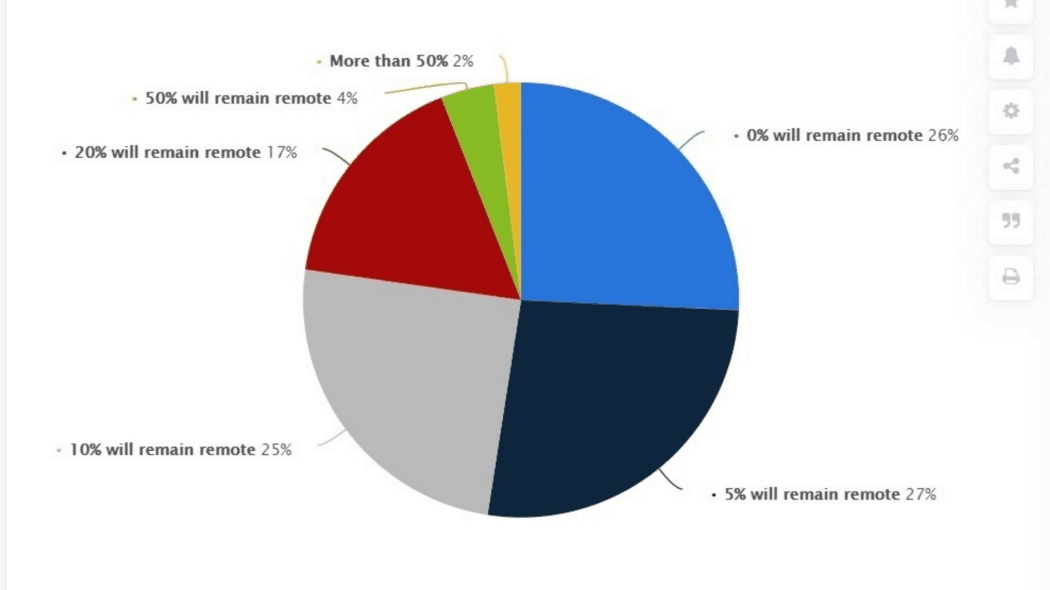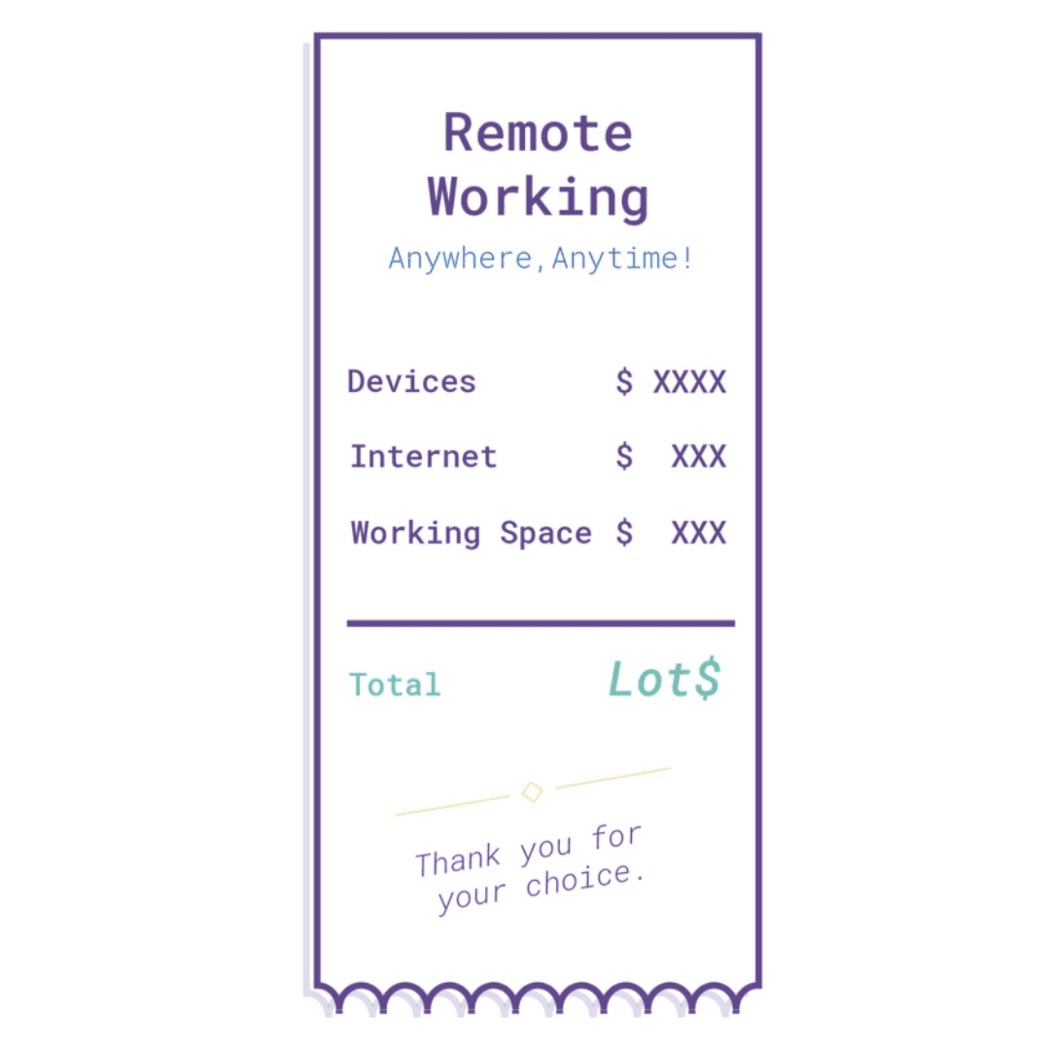The work cubicle is dead. There, we said it.
Sitting in a four-walled cubicle, staring at a monitor and listening to nothing but the clanking of keyboards nearby, a telephone ringing in the distance, and long periods of awkward silence may soon be the stuff of history books.
I should know, I am writing this sitting a stone’s throw away from a paddy field, in a village that is miles away from civilization of any kind.
Welcome to the world of remote working. A lot of people reading this may have heard of the concept and would have experienced a bit of it too, thanks to its friendly cousin — Work from Home.
The coronavirus pandemic has changed our perspective about our workplace and the very idea of working from a designated spot every day. Now, companies are betting on remote working big time.
In a post-COVID world, the statistics of knowledge workers who are not physically present in the office is quite staggering.
Consider, for a moment, these numbers:
- In a couple of American workers surveys conducted in early April and May this year, about half of the pre-COVID 19 employees are now working from home.
- A Bureau of Labour statistics survey states that 47 % of employees will be able to telework.
- 31% of the respondents to a survey said that COVID-19 had been a trigger to allow remote work in their company.
- A Gartner survey also pointed out that 75% of the employees will ask their remote working hours to be expanded by 35%.
- 74% of all the companies surveyed by Gartner plan to shift to remote work permanently post-COVID.
As the virus spread around the world, we had companies such as Facebook announcing that in the next five to ten years, a majority of its employees would be working remotely.
We now know that remote working is not just another passing fad and is here to stay. So what has changed over the past year that has accelerated the remote working scenario?
Let us take a look at three of the major factors contributing to the growth of remote working.
What is pushing the need to work remotely?
- Coronavirus:
This one word has been on our lips, and almost any sentence that you read that ends with “work from home.”
The virus, which is believed to have originated in the Wuhan region of China towards the end of last year, has spread to almost all the countries in the world. The death toll as we write this blog post stands at 774,000.
The need to stop the spread of the virus by maintaining social distancing meant companies across the globe started adopting remote working in the earlier part of the year.
Statista conducted a survey to ask what percentage of a company’s employees will work remote post- corona, and the results were interesting.
With a vaccine taking months to go through clinical trials before being available to the general public, it looks like the coronavirus will leave a dent in the workspace that will make it hard to go back to the way things were.
2. Adoption of 5G technology
5G has been under the limelight for a couple of years now, with the technology expected to revolutionize the mobile telephony market.
Employees will no longer be dependent on an ethernet connection or being tethered to their closest WI-FI hotspot.
I work remotely, and if it weren’t for the 32 MBPS fibernet connection that I have, it would have been impossible to collaborate over a video with some of my colleagues who are sitting close to 1100 miles away.

When we are talking fast, we mean really fast. Remote workers who previously had to deal with huge amounts of data can now use 5G networks, which come with almost zero latency. No more waiting for meetings to launch and images to sync across multiple devices.
There is no question that 5G will be a boon for remote workers, and as the technology reaches widespread adoption, we can hope for more and more companies using 5G in their day-to-day activities.
3. Rise of collaboration tools
Almost a decade ago, no one had heard of Slack (it came out in 2013).
Google Docs was still in its infancy stage, and without broadband internet, collaborating on a document with a person sitting hundreds of miles away was a major pain.
The video conferencing space was dominated by Skype, and you had to get a paid version if you needed to make group video calls.
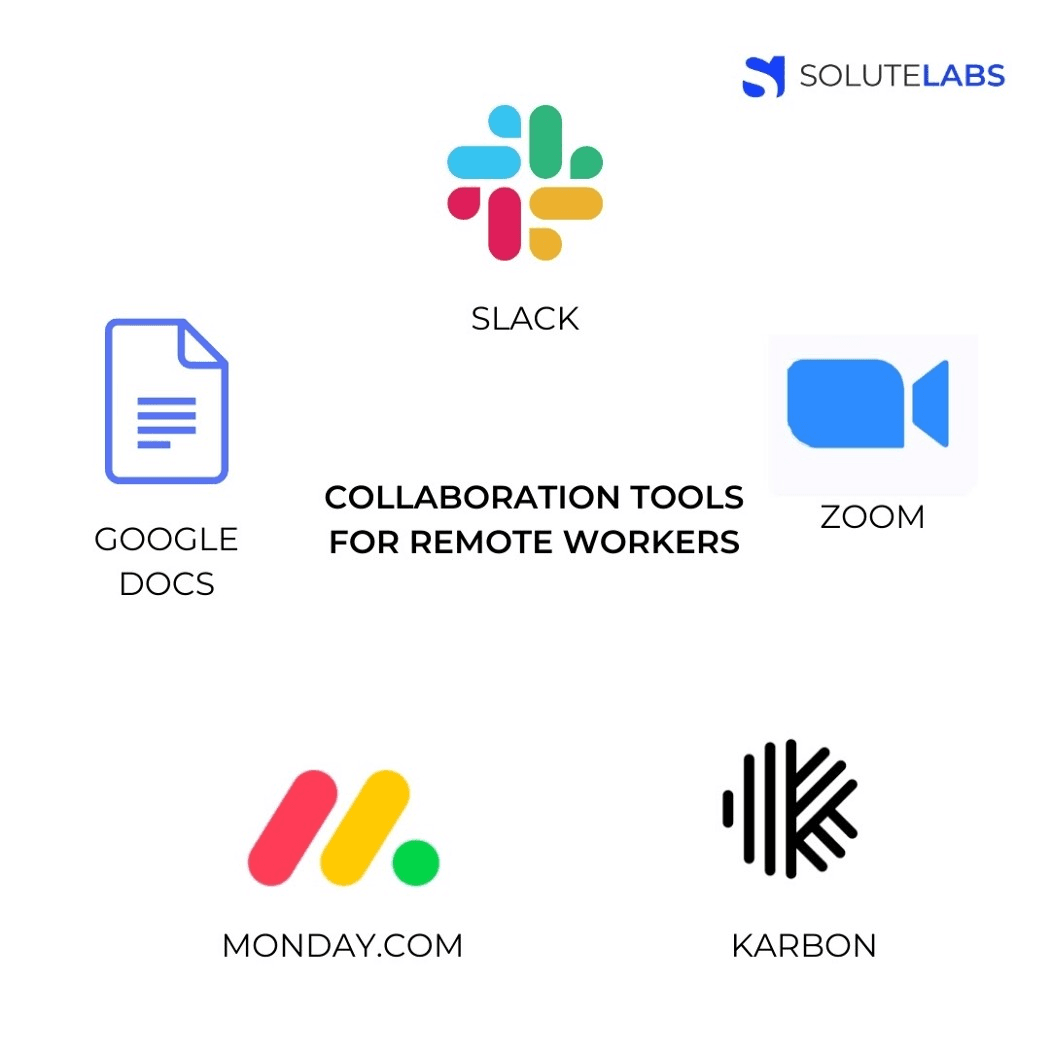
Fast forward to 2020, and we live in a truly connected world where Zoom, Slack, and Google Drive have become synonymous with our working lives.
Today, I can edit a document written by a marketer who sits in a different time zone, group video calls are as simple as creating a link on Zoom and sharing it with the team on Slack, and Google Meets is where we discuss the world issues.
Honourable mentions include monday.com, Nextiva, and Karbon, tools that we have used at one point or another while working remotely.
Now that we know what drives more and more employers to hire remote employees let us see some of the advantages of remote working.
Why Remote working works
- Savings in the infrastructure cost:
Ask any employer, be it a small five-person shop building a software product or a multinational behemoth employing hundreds of people, and the word “Overheads” gives them the heebie-jeebies.
Overheads are costs incurred by a company related to expenses indirectly incurred by an employer by having an employee work at their office.
This may include costs such as office rents, electricity bills, keeping the pantry stocked up, transportation charges if your company provides this option, security and housekeeping charges, etc.
According to Gartner, an average company spends $700 per employee per month on just IT expenses.
According to data collected by Square Foot, the average office space cost per employee is $14,800 in New York, allocating just 200 square feet per employee.
Compare this to $4194 in a city like Atlanta, and you can save a whopping $10000 on infrastructure costs alone if you are moving your employee to work remotely.
Closer home, the average cost of an analytics & BPO company is $24,000 in office, which could come down to $18,000- $20,000 if the employee decides to Work From Home, according to Rohit Kapoor, Vice Chairman and CEO of EXL Service.
Companies are seeing a direct benefit of having employees work remotely, and in the post- coronavirus world, we can expect more and more companies to encourage remote working.
2. Access to a wide range of talent
A strong argument for remote working is that the companies are no longer limited by boundaries when it comes to hiring employees.
Remote employees can be sitting in a different city, state, or even country, spanning multiple time zones.
Take Shopify, for example, which is a fast-growing eCommerce platform based in Canada that caters to over one million businesses in 175 countries.
Earlier this year, the CEO and Co-Founder of Shopify tweeted that the company will move most of its employees “Fully remote” post the coronavirus pandemic.
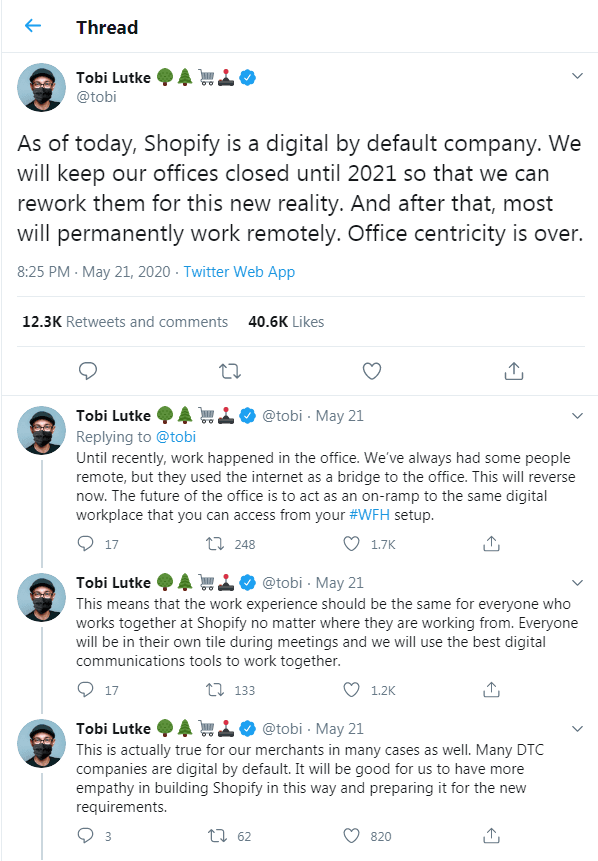
Companies like Upwork and Coinbase are also shifting to a remote-first culture, in an attempt to lure talent who may not be sitting in big cities.
Offering a remote option means you can find the right talent for the job, not just the people who fit the bill and live in a twenty-mile radius. Technology has enabled companies to hire from other countries, with a truly global workforce that lives across multiple geographies.
Add to this the reduced cost in employee transportation, and a remote working option can be projected as a value add when companies are scouting for talent.
A U.S Census Bureau report states that an average employee spends nearly an hour commuting to work and back.
Employees working remotely can now spend this time with their pooch, brushing up their culinary skills, learning to play the piano, etc.
Reduced employee cost, improved employee morale — a win-win for all the stakeholders.
3. Rise of the distributed teams
Remote working has given rise to a unique bunch of organizations that have employees collaborating by sitting in multiple locations, never having met face to face.
Welcome to the world of remote-only organizations. Oooohhhh.. Remote only? You mean there is no physical office, anywhere?
That’s right. Remote only. The increasing emergence of tech means there are companies out there who have 100% of their employees working remotely.
Take X-Team, for example. This platform helps businesses connect with teams of developers who are distributed all across the globe. The company has been operating since 2006 and is to date, 100% remote.
Hotjar is another example of a completely remote company that helps analyze website users and provides insights that will help businesses make better decisions. The company is headquartered on an island in the Mediterranean, with employees spread across Europe, Africa, and America.
Other examples of partially distributed teams include Hubspot, Toptal, and Doximity, to name a few.
Websites such as weworkremotely, remotive.io, and nodesk.co also make hiring remote workers that much easier.
Distributed teams also mean a more ethnically diverse team, each person bringing in their unique perspective to work.
With technology penetration and the increased adoption of collaboration tools, and the coronavirus pandemic pushing for social distancing, we will see more and more of these distributed teams in the coming years.
Challenges with remote working
While we have talked about the pros of remote working at length, it is also important to know a few challenges that remote working throws up that you need to know.
1.Ensuring employee productivity:
There have been a lot of studies conducted worldwide to show if remote workers were actually more productive. While the studies are still inconclusive, some of the results show remote working has increased productivity.
A 2019 study by Airtasker, for instance, found that remote employees worked 1.4 days more than a regular employee in a month, which translates to 16.8 days more every year.
But this study did not take into account the effects that prolonged hours working alone and not having interactions with colleagues had on an average remote-worker.
Man is a social animal and craves having meaningful conversations with other colleagues on a day to day basis, which are best conducted in person and not over a chat window.
A study of 1100 employees by the Harvard Business Review found that a whopping 52% who worked remotely felt that they were more likely to be mistreated and left out.
Virtual teams mean the employers merely see employees as well-oiled cogs in a machine, rather than meaningful contributors to the team. These chance encounters and water-cooler moments prevent employees from burnout and stress.
To prevent this, companies need to conduct regular team meetings over video conferencing tools. If the conditions are favourable, organize for bi-annual physical meetings in a holiday getaway, which ensures that all the teammates know each other and are comfortable working together.
We at SoluteLabs have been a remote-friendly company for a few years now, and we have written a blog post here which you can see on how to build a remote-friendly company culture.
2. Managing distributed teams
All managers have faced some sort of challenge or another with a distributed team, and it is not all that easy to build one up from scratch. Trust us, we at SoluteLabs have a 100% distributed team as we are typing this out.
There is the infamous “Slacker” in every team, and many people complaining that their teammates are not putting in enough effort.
Communication is another challenge we have faced with distributed teams, as different people prefer to do their “Deep Work” at different times of the day.
The solution, of course, is a complex approach where we identify the Slackers, and, instead of punishing them like a kindergarten teacher, we hold them accountable by giving clear deliverables.
Building a culture of mutual respect and understanding is a key pillar to ensuring that your distributed team is as good as a team that is present in-office every day.

We also use Trello, JIRA, and Basecamp to ensure that everyone knows what they are supposed to do on any given day of the week.
Daily stand-up meetings between the founders and different team members are also a way to ensure people are doing their assigned tasks for the day.
At the end of the day, it all comes down to one word- TRUST. We trust our employees to do their work, and they, in turn, trust us not to micromanage them.
3. Ensuring privacy and Data security
One of the challenges employers face while having a remote team is to ensure that all the company data is safe, and no third party has access to sensitive data.
There is a separate term for employees using unofficial apps or non-company approved software to get their work done — Shadow IT.
To prevent this, as a first step, ask all your remote employees to have a dedicated office space for work in their home. While this may sound like an oxymoron, it helps prevent employee’s systems from being accessed by an outsider who has a different WiFi hotspot, since employees only connect to their home networks if they have a dedicated space.
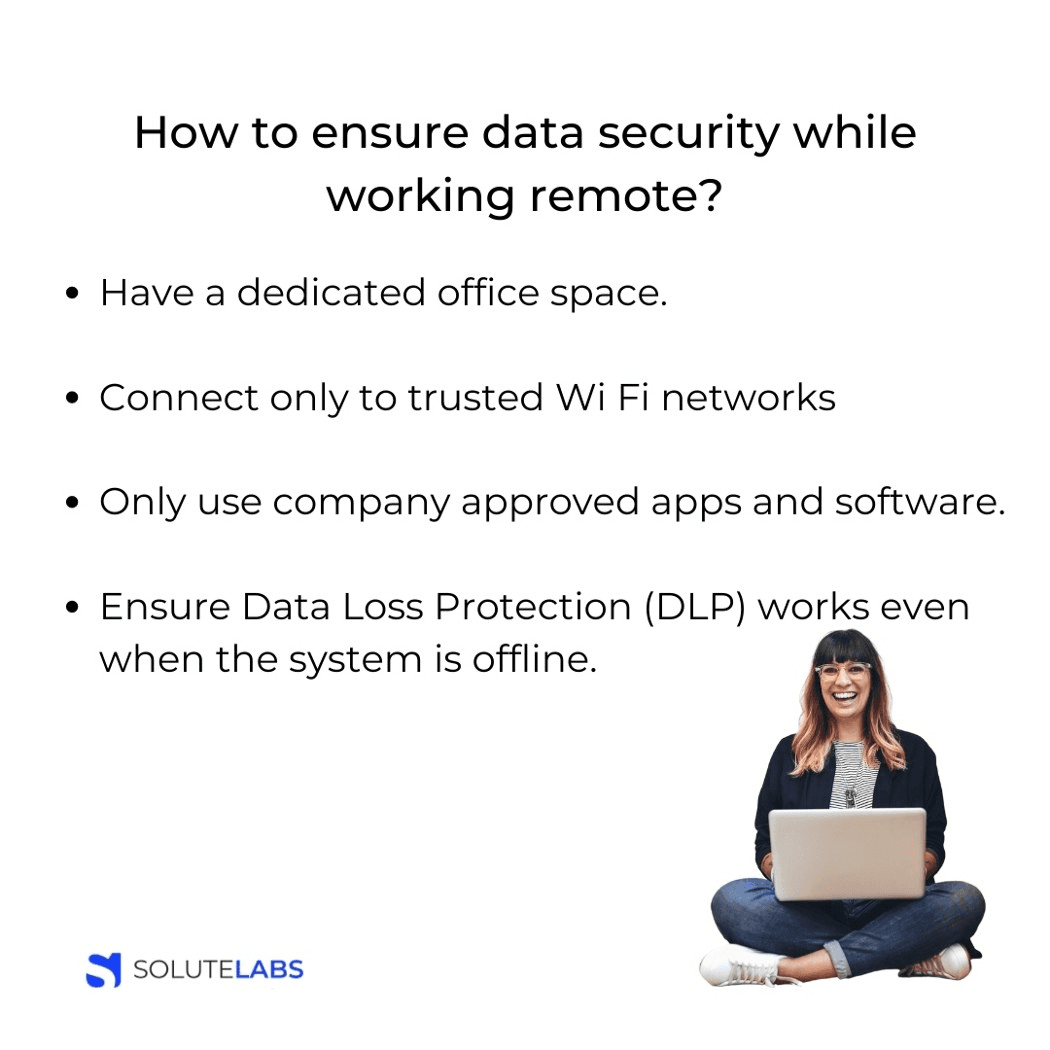
Give clear guidelines to all your remote employees on the organization’s IT policies, and ask them to connect to only trusted WiFi hotspots.
To prevent the spread of Shadow IT, employees must be encouraged to use only company approved software and applications, preferably installed by the company’s IT admin.
And as the last stage, ensure that all your Data Loss Prevention (DLP) systems work even when the computer is not connected to the internet.
Using Google authenticator to access your Automation software, say Hubspot, is also an easy way to ensure data protection.
Parting words
By now, you have an idea about why remote working works and the challenges you may face while working remotely.
The one thing we want to make absolutely clear is that remote working is slowly going to take more and more inroads into the traditional work-from-office model. The millennials, the next generation of employees, will only be happy to work from a location of their choice.
More and more companies will now offer remote working options, especially in the face of the coronavirus, to capitalize on savings in infrastructure and reduced overhead costs.
While we acknowledge that not all the positions in an organization can be made remote and companies will still need a physical office, the culture of working outside the office is here to stay.
If you want help setting up a distributed team, or are looking for solutions to enhance your digital presence, give SoluteLabs a call, and we will be happy to help you out.

